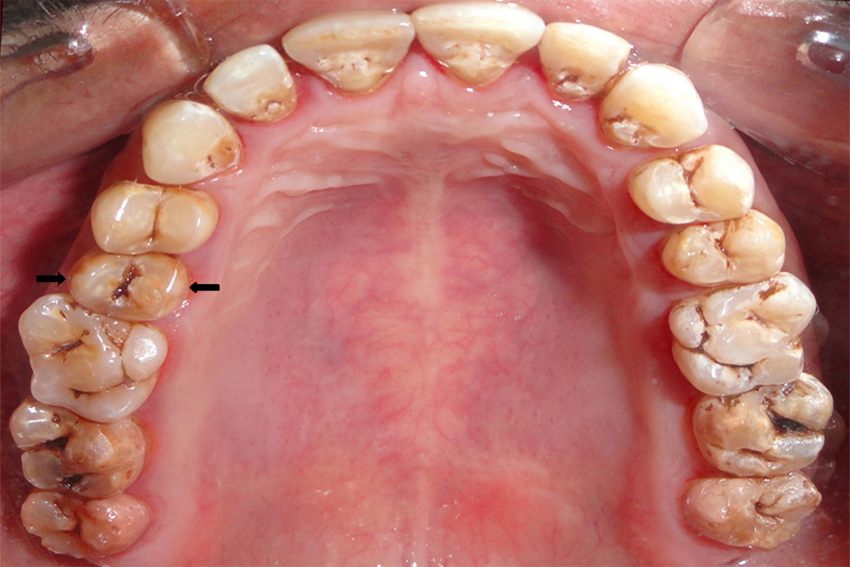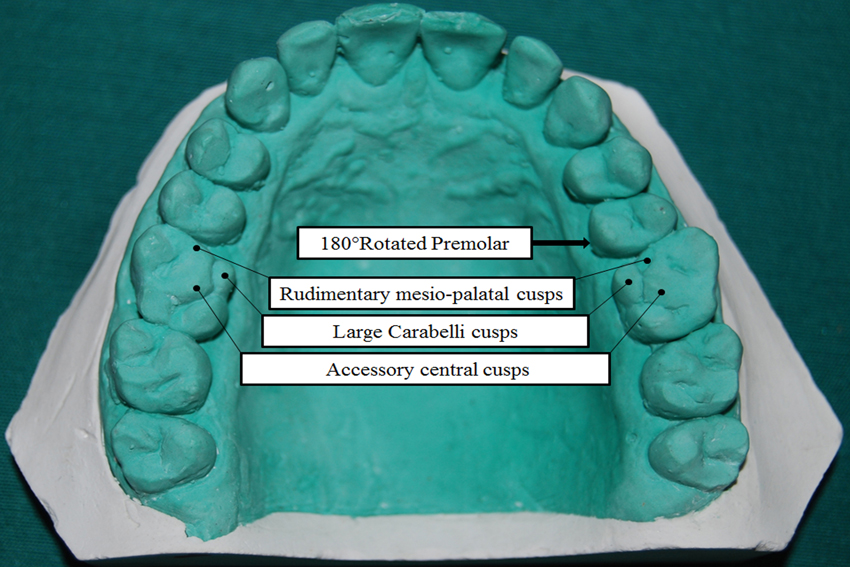A Variation in Tooth Position-180° Rotated Maxillary Second Premolar
Gurudutt Nayak1, Inderpreet Singh2
1 Reader, Department of Conservative Dentistry and Endodontics, Kanti Devi Dental College and Hospital, Mathura, Uttar Pradesh–281006, India.
2 Senior Lecturer, Department of Conservative Dentistry and Endodontics, Dasmesh Institute of Research & Dental Sciences, Faridkot, Punjab– 151203, India.
NAME, ADDRESS, E-MAIL ID OF THE CORRESPONDING AUTHOR: Dr. Gurudutt Nayak, Reader, Department of Conservative Dentistry and Endodontics, Kanti Devi Dental College and Hospital, Mathura, Uttar Pradesh– 281006, India.
Phone: +91-9997259742,
E-mail: gurudutt_nayak@hotmail.com
Rotation of a tooth around an axis which is perpendicular to the occlusal plane through angles which approach 180° is a rare anomaly which is found in the human dentition. Such aberrations present a multi–factorial model in their origin. Both genetic and local factors seem to contribute to this abnormality. If the contribution of local factors could be identified, a way could open to an early treatment and prevention of secondary rotations of opposing and contiguous teeth. A case of a 180° rotation of maxillary left second premolar in a male patient of Indian origin has been described here.
Maxillary premolar, Morphogenic fields, 180° rotation
Case Report
A 37–years old male patient of Indian origin was referred to the Department of Conservative Dentistry and Endodontics for treatment of carious teeth. An intraoral examination revealed an Angle’s Class I molar relation with a well aligned upper and a lower arch. Full complement of permanent teeth was present. Generalized dental fluorosis was seen in teeth of both arches. Though the teeth were in good contact in the posterior segment, an interdental spacing was observed in the anterior quadrant. It was interesting to find that the maxillary left second premolar was rotated through 180°, with its buccal surface facing palatally and its distal surface facing mesially [Table/Fig-1 and 2]. Premolar arrangement was normal in the other three quadrants. In addition, bilateral accessory central cusps were observed on the occlusal surface of maxillary first molars.
Intraoral photograph showing 180° rotated maxillary left second premolar (arrow) with bilateral accessory central cusp on maxillary first molars

Occlusal view of the subject’s dental cast showing 180° rotated maxillary left second premolar with bilateral accessory central cusp on maxillary first molars

Patient’s medical history was non-contributory and there was no sign of any systemic diseases or syndromes. Patient’s familial history could not be traced, as his family was unavailable for examination. The patient was unable to recall whether he had lost any deciduous teeth prematurely or not. Small wear facets were seen generally on the occlusal surface of the molars and especially, bilaterally, on the inclines of the central cusps of maxillary first molars and on the ‘palatal’ cusp of maxillary right second premolar. Facetting was observed, as these cusps interdigitated, in occlusion with the opposing mandibular teeth. The ‘buccal’ cusp of maxillary left second premolar was intact, with no facetting. The buccal cusp which faced palatally was present at a higher level than the palatal cusp, as it usually should be. The alveolar bone and periodontal ligament around the rotated tooth were healthy. A radiographic investigation revealed a single root tooth with a Vertucci’s Type I canal configuration.
Discussion
The rotation through 180° of the maxillary left second premolar, as has been reported here, is certainly an unusual anomaly, with only few cases being reported in dental literature [1,2]. Many authors have attempted to explain the aetiology of teeth rotations or their displacements. One possibility, of course, is that the premolars tooth crypts may have formed in the wrong positions and that the teeth’s erupted malpositions may be reflecting this developmental anomaly [3]. Moore [4] attempted to explain the 180° rotation of premolars with the so called ‘theory of axial gradients’. Part of the theory suggests that the polarity of a cell is determined by its metabolic rate. The polo with highest metabolic rate develops into the ‘head’, the other one develops into the ‘tails’. On applying this theory to 180° rotated premolars, it would seem that through some ‘accidents of nature’, the lingual portion of the tooth germ may have grown at a faster rate than the buccal portion and that thus, the lingual portion of the tooth germ may have just grown into a ‘buccal’ cusp.
This scenario may also be due to premature loss of primary molars, that affects the eruption tempo of its successor. The two primary molars in a quadrant can be viewed as space holders for the later-emerging premolars. If one or both primary molar/s is lost prematurely because of caries, the permanent first molar will drift forward, diminishing the space which is available for normal eruption of the premolar, thus leading to a failure in eruption (impaction) or ectopia of one or both premolars in a quadrant [3]. Another possible explanation may be that after the second premolar has erupted into a rotated position, the eruption and subsequent mesial drift of the second molar could further rotate the second premolar right round to 180° [2].
Morgan [5] attributed the effect of a prolonged retention of deciduous teeth to a premolar rotation. He felt that if the deciduous predecessor was not shed by the correct time for eruption of the premolar, the eruptive pressure would tend to rotate the permanent tooth, as the cone-like shape of the resorbing roots of the deciduous tooth would tend to hold the premolar upright. Kim et al., [6] studied the effect of various local factors on lower premolar rotation. They found that the mean rotations of premolars were increased in cases of asymmetrical root resorption of deciduous predecessors, pathological involvement of deciduous molars, and loss of the first permanent molar, in order of increasing mean rotation. Seipel [1] is of the opinion that rotation of teeth is usually concomitant with crowding and that the space which is allotted for a tooth is so large as to interfere with a proximal contact. However, the rare instances of extreme rotation cannot be explained by overcrowding, because rotation through angles of greater than 135° would not ordinarily result in shortening of the length of the tooth row.
Positional anomalies and many other morphological variations have been attributed to morphogenic fields. Butler [7] proposed that each tooth germ in the maxilla or mandible possessed the same genetic information, which would allow any single tooth germ to develop into any type of tooth. It was only the tooth germ’s position in the maxilla or mandible that determined as to what type of tooth the tooth germ would ultimately develop into, being directed by some field substance or morphogen. In addition to Butler’s three morphogenic dental fields, namely incisor, canine and molar, Dahlberg [8] defined a fourth, “premolar” dental field. But controversy exists, whether premolars should be distinguished as a separate dental field which was away from the molar field. Some researchers have stated that premolars are an anterior extension of the molar dental field and others have noted that crown and root morphology supports the existence of a distinct premolar dental field [9]. Applying the theory of morphogenetic fields to explain the anomalies which were observed in our patient, goes on to tentatively support the existence of a separate molar morphogenic field, while making the evidence of a separate premolar morphogenic field slightly less equivocal.
Conclusion
Although recent findings have increased our knowledge on the mechanisms of tooth morphogenesis, the genetic or morphogenetic mechanisms that produce extreme rotations of teeth are still unknown. Furthermore, there is no obvious explanation for the restriction of an extreme rotation to isolated teeth or contralateral pairs, the unexpectedly high frequency of bilateral rotations, or the differential distribution of rotations within the dentition. The present case report was expected to contribute to the community’s knowledge base, with the hope that the description would stimulate discussions from the readership.
[1]. Seipel CM, Variations of tooth position: a metric study of variation and adaptation in the deciduous and permanent dentitionsSven Tandlak. Tidskr 1946 39:369-72. [Google Scholar]
[2]. Tay WM, Rotated maxillary second premolars two cases with 180 degree rotationBr Dent J 1968 124:326 [Google Scholar]
[3]. Harris EF, Commentary: Rotated premolarsDental Anthropology 2006 19:74-78. [Google Scholar]
[4]. Moore WA, Dent Dig 1953 59:348 [Google Scholar]
[5]. Morgan GE, Prolonged retention: when should healthy deciduous teeth be extracted?J Am Dent Assoc 1938 25:258-63. [Google Scholar]
[6]. Kim JH, Shiere FR, Fogeus HR, Pre-eruptive factors of tooth rotation and axial inclinationJ Dent Res 1961 40:548-57. [Google Scholar]
[7]. Butler PM, Studies of the mammalian dentition. Differentiation of the post-canine dentitionProc Zool Soc Lond 1939 109:1-36. [Google Scholar]
[8]. Dahlberg AA, The changing dentition of manJ Am Dent Assoc 1945 32:676-90. [Google Scholar]
[9]. Stefan VH, Brief Communication: Rotation of the Maxillary Premolars: Evidence in Support of Premolar Morphogenetic FieldDental Anthropology 2006 19:70-73. [Google Scholar]